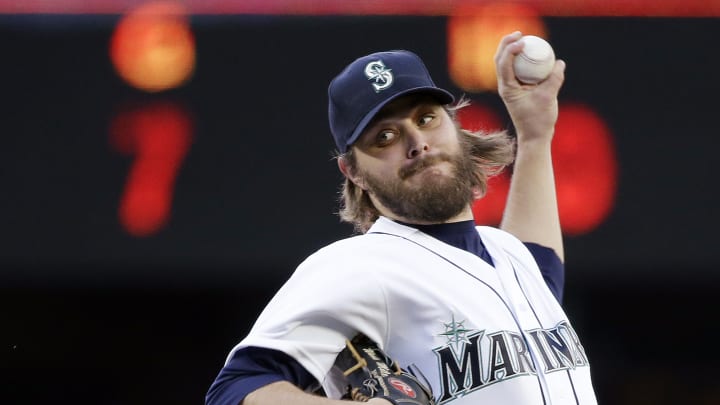Prospect of smaller strike zone proves no hit with pitchers

NEW YORK (AP) Wade Miley hears the talk about lifting the bottom of the strike zone in an effort to spark offense and insists there has been too much tinkering already.
''I don't know why they just can't leave the game alone,'' the Seattle pitcher said. ''Can't we just go play and try to get three outs and go from there?''
Concerned about the drop in offense in recent years, Major League Baseball has studied whether to restore the lower edge of the strike zone from just beneath the kneecap to its pre-1996 level - at the top of the kneecap. Any change for 2017 would require an agreement with the players' association, which is skeptical. Membership is split.
''I think it's kind of outrageous what they're trying to do with the strike zone,'' Los Angeles Dodgers left-hander Alex Wood said. ''Obviously, I'm biased. I'm a pitcher. But at the same time, it's shrunk drastically, maybe even in the last five or six years.''
Baseball people talk about the strike zone the way most discuss the weather: constant complaints about hard-to-fathom change.
Wood threw 11.9 percent of his pitches last year at the bottom of the strike zone, according to Fangraphs, which defined the lowest portion as between 1.5 and 1.75 feet off the ground. That was the highest-percentage in the major leagues, just ahead of Minnesota's Kyle Gibson at 11.3 percent and Miley's 11 percent.
When the strike zone was last changed, umpires took years to adjust.
MLB has used computer software to track umpires' strike zones since 2001, which has helped bring the umpiring staff into closer alignment on balls and strikes. Umpires receive a grade now after every game worked behind the plate, and that has resulted in an expansion of the strike zone over much of the past decade.
Any adjustment to a new rule-book definition would take time.
''They'd have to start in the minor leagues. I think for some of the guys to try to adjust to a new strike zone is going to be chaotic,'' said umpire Bob Davidson, who worked his first big league game in 1982. ''I hope they just leave it the way it is. I think we call it now the way the rule book states.''
Offense has increased this season. Through Thursday's games, the big league batting average is .256, the highest for a first half since 2010, and teams have combined for 2.31 homers per game, the most in the first half since the Steroids Era peak in 2000.
But one trend remains constant: strikeouts.
Teams combined to average 15.95 strikeouts per game in June, the third-highest month in major league history behind September 2015 (15.96) and April 2016 (16.26), according to the Elias Sports Bureau. The last 28 months dating to September 2011 are the highest-strikeout 28 months in big league history.
''We're at an interesting time in the game,'' Gibson said. ''I think they should ask players about strikeouts and how much they care about strikeouts because I don't think it's as frowned-upon as it used to be - because a guy who's striking out a lot is probably also hitting a lot of homers. And if you ask anybody in here if they'll take a 150-strikeout and 30-homer year, they're going to say, yeah, sign me up.''
The strike zone has changed many times - by definition, not just opinion, like Chicago Cubs manager Joe Maddon calling Laz Diaz's zone last weekend ''amorphic.'' The top was moved from the armpits to the top of the shoulders ahead of the 1963 season, then lowered before 1969 following a drop in offense and redefined in 1988 as the midpoint between the top of the shoulders and the top of the uniform pants.
''If the bottom came up, would the top come up, too?'' said Toronto pitcher R.A. Dickey, the 2012 NL Cy Young Award winner. ''If they want to introduce an era of better offense, then that would be one way to go, for sure. Because if you're having to elevate balls, that's right into the swing path of most hitters.''
But just raising the bottom alone likely would result in only a slight change.
''I think that's a tough pitch for umpires to call already. Not only are they blocked a little bit by the catcher, but the pitches that I throw down there aren't straight four-seamers. They're sinking down already,'' Gibson said. ''I think most of those probably aren't called strikes. They're probably groundballs or swings and misses or foul balls. ... But, yeah, raising the strike zone for me is going to be a little more difficult, depending on how they call that. But it's just like any other rule change. Just like the slide rule at second. I'm going to have to make an adjustment and hopefully it's not an adjustment that causes me to get hit a whole lot.''
